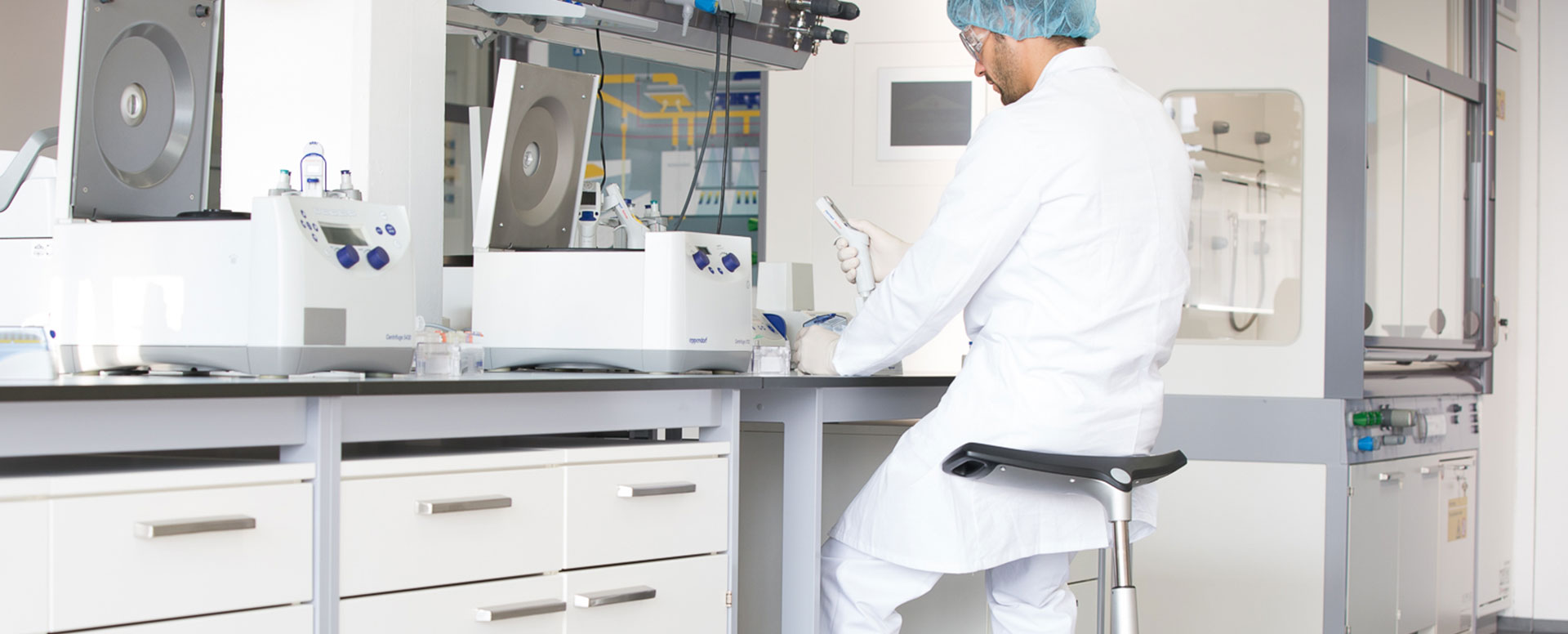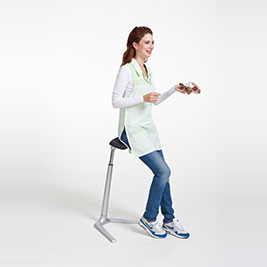
Continuous standing work – effects, tips and aids
Around half of all workers in Germany currently work while standing, across a variety of different industries. These include research firms and companies that manufacture products as well as the service sector. The impact of standing work of this kind leads to health problems, since the human body is not designed to stand in one position for long periods, but should instead be switching between sitting, standing and moving. Movement and workplaces that have an ergonomic design with stand aids can help to prevent adverse affects on health.An overview of our article
- The impact of standing work
- How can we counteract the effects?
- Excursus: Stand aids
- What is a stand aid?
- What benefits do stand aids bring?
- What are the features of a good stand aid?
- FAQ on stand aids
- Summary
- Our white paper on the subject of standing work
1. The impact of standing work
The human body is designed to alternate between various positions – standing, sitting, lying down, walking and many other forms of movement. Standing in one place for a several hours at a time each day, however, places the body under unnatural one-sided strain. There are several health-related problems that such standing work can cause, such as venous disorders and varicose veins. This is due to the fact that the veins need to pump blood from the legs back up in the direction of the heart all throughout the day, using a great deal of pressure to do so. If a person stands still for hours on end, the blood in their system will exert a large amount of pressure on the vessel walls and venous valves. These can expand and become abnormal, leading to problems such as circulatory disorders and varicose veins.
Many people who work at a standing workstation without some form of support such as a stand aid often complain of neck and back pain. This is primarily due to insufficient movement of the spine, which has a negative impact on the intervertebral discs. When the body has to stand upright and remain balanced for an extended period of time, this can lead to muscular tension and cramps. The joints, particularly the knees, soon show signs of wear. Furthermore, the arch of the foot can collapse from standing around on hard surfaces and/or in unsuitable shoes for extended periods, resulting in "flat feet". Further details on the impact of standing work in relation to health can be found here.
2. How can we counteract the effects?
In truth, relatively simple methods can be used to prevent the undesirable consequences of working at a standing workstation. The difficulty primarily lies in motivating oneself as an individual to integrate these simple methods into the hectic pattern of everyday working life.
a. Floors and furnishings
A hard floor made of concrete is an unnatural surface to stand on and can be incredibly damaging to the skeletal and muscular system. Elastic mats that are rolled out on the standing workstation not only ensure that a person's foot makes contact with the ground differently each time, but also that their feet keep moving: The softer surface causes the standing worker to remain in motion, making slight, imperceptible adjustments to retain their balance and weight distribution – and that alone works miracles. Legs feel less tired and heavy as a result, and thanks to the insulating properties of the anti-fatigue mats, employees less frequently complain of cold feet as well.
In addition, there should be enough space available to walk a couple of steps or stretch out if necessary. Ideally, the employer should also provide seating options and stand aids so that the standing worker can take short breaks when needed.
b. Sport and movement
It is a good idea for employees that spend most or all of their time standing up while working to take exercise in their free time to counteract the one-sided strain of remaining in a standing position throughout their workday. Disciplines such as pilates or gymnastics that place the whole body in motion and necessitate regular stretching are perfect examples of suitable activities. However, more conventional forms of exercise such as walking, jogging and swimming will also help substantially. During lunch breaks, going for a walk is a much better option than sitting down: The legs will remain just as still when sitting, meaning that nothing will be done to stimulate the flow of blood.
Experts recommend incorporating small movements into working habits that can be performed at one's discretion, such as briefly coming up onto the tips of the toes or alternating the load on each leg by extending the opposite leg forwards. A couple of free minutes here and there can also be used for a wall sit, an exercise in which you stand slightly in front of a wall and then slide your back down against it until your knees are at a 90° angle. This position requires a certain amount of strength to hold, yet is highly beneficial for your body after prolonged periods of standing. More information on how movement can be used to counteract the impact of standing work can be found here. .
c. Switching between sitting, standing and moving
The best thing for the human body is to regularly alternate between different positions and switch between standing, sitting, walking, running and lying down. Muscles and joints should be loaded evenly throughout the course of the day. Accordingly, ergonomic workstations that facilitate frequent shifts in position help to safeguard the health and well-being of employees and reduce the number of absences due to illness. Such workstations are not always feasible for many working roles, however, so employees should take advantage of their breaks to move around as much as possible.
d. Stand aids
If only limited opportunities are available to break up prolonged work in a standing position through position changes, then stand aids are the next best solution. They alter body posture only minimally and allow an employee to carry out all movements that they would perform when standing. At the same time, stand aids reduce the strain on the entire musculoskeletal system and consequently prevent the onset of long-term damage and chronic illness.

3. Excursus: Stand aids
a. What is a stand aid?
Stand aids are part of the product family of workplace chairs. They support people who carry out standing work. In contrast to conventional workplace chairs, stand aids have a smaller seat surface (width and depth). Additionally, the seat height often significantly exceeds that of normal workplace chairs. Other USPs include a low weight and reduced external dimensions. Many foldable versions are also available.
A good stand aid allows an employee at a standing workstation to lean against it and support themselves without taking their feet off the floor. It facilitates their ability to work without impeding them in their movement. An ergonomic and space-saving design ensures that it can be easily transported and adjusted in height. Ideally, the height will be able to be adjusted to any position within the range of 65–80 cm. It is important that the stand aid is highly stable while at the same time ensuring that the employee has complete, unimpeded freedom of movement. Most people that can benefit from a stand aid work in a slightly forward-inclined posture. For such people, a support surface that is inclined by approximately 15% is ideal, as this will support around 60% of body weight and consequently facilitate the flow of blood in the legs. The seat surface is wide and has a rounded-off front edge, meaning that it will not leave any pressure marks. A good stand aid comes with a guarantee and the necessary marks of conformity, such as the GS ("Geprüfte Sicherheit") mark that indicates the product has been tested and certified in accordance with German safety requirements.
Stand aids must always be adapted to the respective workplace: To protect against flying sparks or oily substances in industrial workplaces, the cover material must be particularly robust. Dissipative materials are used in areas with a possibility of electrostatic discharge (ESD). Stand aids without joints are manufactured for laboratories to avoid having any gaps into which bacteria or contaminating substances could penetrate. And when it comes to offices and the services sector, comfort and design are naturally of the utmost importance.
b. What benefits do stand aids bring?
Using a stand aid does not restrict the ability to work; rather, it allows body weight to be distributed differently and the load to no longer be borne exclusively by the feet. Thanks to the stand aid, an employee's movements place less strain on their back, and their leg and foot posture is varied and more optimally aligned in contrast to unassisted standing. This stimulates the flow of blood. The slightly modified angle causes the muscles and joints to move a little differently to how they would when standing without a stand aid, and the load is no longer as one-sided as before. Use of a suitable stand aid can help to prevent both short-term and long-term ailments, in turn cutting down on employee absence due to illness.
c. What are the features of a good stand aid?
A good stand aid can be adjusted in height and adapted to the requirements of the workplace. It can transported quickly from A to B and, since it can be adjusted with a handle, it can also be used by multiple employees in succession. There are a number of models available that are just as diverse as the standing workstations themselves. Even if body posture is changed only slightly, the variation in posture caused by the stand aid alone is sufficient to ward off pain and prevent lasting damage. Some of the models only provide assistance for supporting one's own body weight, while others allow a mixture of standing, sitting and even bouncing. How suitable a certain stand aid is for a particular workplace depends entirely on the tasks to be carried out in that area.
Stand aids are frequently used in specialised environments such as cleanrooms or laboratories, for example. In such cases, they must conform to specific standards in order to prevent contamination. Other models, by contrast, are specially designed for industry and optimised for use by those who manufacture, in the sense that they are robust, resistant and easy to clean. In short, you will find a suitable stand aid for any area or sector you can think of.
d. FAQ on stand aids
Where can a stand aid be used?
Anywhere where standing work is required and consequently impacting on the health of employees. For those who manufacture, for example, a stand aid that is inclined forwards is most suitable as it will reduce the reaching distance to the working area. Stand aids are also ideal for employees stationed behind bars or sales counters, who are able to maintain an upright position even if they are not serving someone: This allows them to remain visible and approachable whilst resting their muscles, joints and bones.Does a stand aid not get in the way?
A stand aid is not the same as an office chair, which may well be comfortable, yet also takes up a lot of space. Stand aids are significantly narrower and also have a much smaller surface to sit or lean on. Since in most cases there is no backrest (and usually no armrests either), stand aids only take up a small amount of space and can simply be placed out of the way in a corner when not required.Are different stand aids required for different people?
Large organisations in particular employ people of many different shapes and sizes: They can vary in height and weight and may be short-limbed or long-limbed. That said, it is not necessary to obtain a specific stand aid for each person. Since these practical supports can be adjusted in height, a single type of stand aid will suffice for all employees.
4. Summary
Standing work can place significant strain on the human body and lead to chronic illness. An employer can improve working conditions for their employees by giving them the opportunity to switch between standing, sitting and moving. Ergonomic workplace design can also be beneficial. Workspaces can be enhanced with anti-fatigue mats, chairs with armrests for breaks, sufficient space to move about in and stand aids for support if required. The latter are available in a variety of different forms that make them suitable for all kinds of standing workstations. They can be adjusted in height and used by all types of people.
5. Our white paper on the subject of standing work
More information on the subject of standing work and the complications that it can entail – along with possible solutions to combat these – can be found in our white paper.

1

0
back to overview
 print
print
